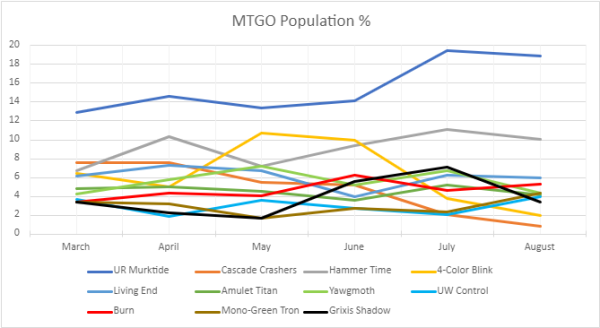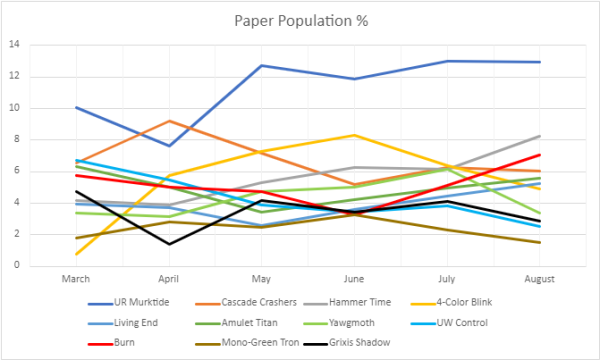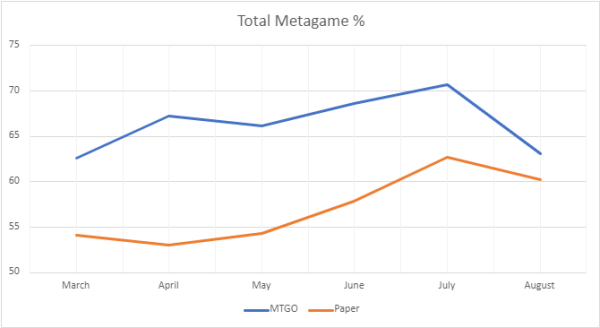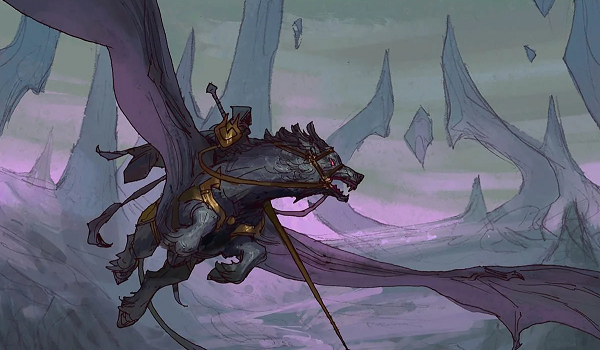Are you a Quiet Speculation member?
If not, now is a perfect time to join up! Our powerful tools, breaking-news analysis, and exclusive Discord channel will make sure you stay up to date and ahead of the curve.
I'd like to open this month's metagame analysis article with a cliche about the inevitability of change. I leave it to the reader to pick which one. They're all equally applicable. Modern is in a weird position, which means there's a shift in the winds. The metagame doesn't look very different for the average player. However, diving into the data shows that there's considerable change occurring. Whether these particular shifts are indicative of a sustained shift is impossible to say, but given that Dominaria United (DMU) just became legal, Modern should have some churn for the next month.
Time For the Check-Up
First things first, time to check in on the experimental groups. I've been tracking how the top 11 decks from March have been performing, and it revealed a worrying upward trend. I was anticipating August to follow trend and indicate Modern was dangerously concentrated. This did not occur, and the Magic: Online (MTGO) data is quite dramatic.
| Deck Name | March % | April % | May % | June % | July % | August % |
|---|---|---|---|---|---|---|
| UR Murktide | 12.92 | 14.65 | 13.37 | 14.14 | 19.46 | 18.93 |
| Cascade Crashers | 7.58 | 7.55 | 5.49 | 5.20 | 2.09 | 0.79 |
| Hammer Time | 6.74 | 10.3 | 7.16 | 9.36 | 11.09 | 10.06 |
| 4-Color Blink | 6.46 | 5.03 | 10.74 | 9.98 | 3.77 | 1.97 |
| Living End | 6.18 | 7.32 | 6.68 | 3.95 | 6.28 | 5.92 |
| Amulet Titan | 4.78 | 5.03 | 4.53 | 3.53 | 5.23 | 4.14 |
| Yawgmoth | 4.21 | 5.72 | 7.16 | 5.20 | 6.69 | 4.34 |
| UW Control | 3.65 | 1.83 | 3.58 | 2.70 | 2.09 | 3.94 |
| Burn | 3.37 | 4.35 | 4.06 | 6.24 | 4.60 | 5.32 |
| Mono-Green Tron | 3.37 | 3.20 | 1.68 | 2.70 | 2.30 | 4.34 |
| Grixis Shadow | 3.37 | 2.29 | 1.68 | 5.61 | 7.11 | 3.35 |
Modern's outlier best deck, UR Murktide, saw a statistically insignificant drop in August, but runner-up Hammer Time had a meaningful drop-off. This was accompanied by a number of other decks crashing while only a few saw meaningful upticks. This is more obvious on the graph:

The gaps are still quite large between the outlier decks and the rest, but there's clearly been a net decline. What's most strange is how widely these trends differ from the paper results:
| Deck Name | March % | April % | May % | June % | July % | August % |
|---|---|---|---|---|---|---|
| UR Murktide | 10.08 | 7.64 | 12.75 | 11.88 | 13.02 | 12.96 |
| Cascade Crashers | 6.52 | 9.20 | 7.16 | 5.20 | 6.26 | 6.06 |
| Hammer Time | 4.15 | 3.90 | 5.30 | 6.25 | 6.13 | 8.25 |
| 4-Color Blink | 0.79 | 5.77 | 7.31 | 8.28 | 6.39 | 4.88 |
| Living End | 3.95 | 3.74 | 2.58 | 3.59 | 4.47 | 5.22 |
| Amulet Titan | 6.32 | 4.99 | 3.44 | 4.22 | 4.98 | 5.56 |
| Yawgmoth | 3.36 | 3.12 | 4.73 | 5.00 | 6.13 | 3.37 |
| UW Control | 6.72 | 5.46 | 3.87 | 3.43 | 3.83 | 2.52 |
| Burn | 5.73 | 4.99 | 4.73 | 3.28 | 5.11 | 7.07 |
| Mono-Green Tron | 1.78 | 2.81 | 2.44 | 3.28 | 2.30 | 1.52 |
| Grixis Shadow | 4.74 | 1.40 | 4.15 | 3.43 | 4.09 | 2.86 |
Murktide continues along effectively unchanged but everything else is in chaos. July represented a convergence of sorts but that has gone out the window. Many decks have continued the previous trends, but many others have gone wildly rogue.

Also worth noting is that the overall gap between Murktide and the rest of the sampled decks shrunk. In fact, taking Murktide out of the equation makes the overall picture look like a pretty healthy metagame.
An Improvement
Which leads nicely into my main point. Modern appears to have been much healthier in August. In July, I sounded the alarm over metagame concentration when the MTGO sample accounted for 70% of the field. I'm pleased to say that I don't need to do that this month.
| March % | April % | May % | June % | July % | August % | |
|---|---|---|---|---|---|---|
| MTGO | 62.63 | 67.27 | 66.13 | 68.61 | 70.71 | 63.1 |
| Paper | 54.14 | 53.02 | 54.31 | 57.84 | 62.71 | 60.27 |
MTGO's concentration fell by 7%, which is statistically enormous. Paper's 2% fall is less impressive, but still meaningful. Given that the only one of these decks which didn't make the tier list is Cascade Crashers and that was only true of MTGO is especially important, indicating a diversification. Even though the total number of decks on the list is lower than some months.

MTGO's concentration has fallen to a level not seen since March, while paper's is still up on net. This might be a sustained trend, or it might not be. It's only one data point. However, it is a good sign that Modern is at least trying to shake itself out of the doldrums and get some fresh blood into the mix.
Be Cautious
So, remember a few paragraphs ago when I said that Modern appears healthier because the sample's concentration is down? Appears is the operative word. Refer back this week's data article. Blink is being replaced by 4-Color Control online, and if I'd switched out Blink's number for Control's, then MTGO's concentration would be substantially higher.
It's also worth remembering that the surging Indomitable Creativity decks aren't included in the sample. They just weren't played at the start of the study period. At least some of the loss of metagame share that the sampled decks suffered can be placed at Creativity's hands, and I suspect that were this study a comparison of just the top decks rather than a fixed series, the overall concentration would be unchanged at best.
Getting Creative
On the subject of Creativity decks, what's up with the surge? Creativity has been around for quite a while and hasn't performed. There have been several variants hanging around since March, but they've always been in Tier 3. The Temur version cracked Tier 2 and has been on a steady upward trajectory since June, with many other versions starting to filter into Tier 3. What's going on?
First of all, I don't believe that this is an actual metagame shift. Creativity has been part of Modern for months and is just doing better suddenly. That can just happen as players get bored of decks and move on rather than representing an actual change in viability. This is also my second-best explanation for why Omnath, Locus of Creation players swing between playing Ephemerate or not on a monthly basis.
Rather, to me this surge smacks of players finally optimizing the deck. There have been a number of different Archon of Cruelty decks since Modern Horizons 2, but none have good enough to maintain metagame presence. The newish Temur Creativity may have solved the puzzle. Whether it can sustain the push is another matter.
Art Criticism
First, to be clear, Archon does not count towards any deck's color identity. It's a payoff to be cheated out rather than cast. Thus, while Temur Creativity has Archon in the deck, all the spells that it intends to cast are red, blue, or green.
When all this began, Creativity was essentially 4-Color Control altered to support Creativity. This always made the deck weirdly unstable, at least in my experience. All the control elements were still there, but unlike the Omnath decks, it didn't drown the opponent in card advantage. It cheated out Archon and hoped that was good enough. The constraints imposed on the manabase to make Dwarven Mine work made it harder than necessary to meet all the color requirements. Consequently, 4-Color Creativity was and continues to be pretty mediocre.
However, the appeal of Creativity into Archon is great enough that players have been trying to fix the problem since it was identified. One of the earliest attempts was effectively hybridizing the deck with Reanimator to get Grixis Creativity. On paper it makes sense. Looting effects find Creativity while setting up Persist, and there are two options to cheat out Archon. Which does work, but not consistently. The data shows that when Creativity wins, it wins big, but those wins are sparse. That's how it goes with split-plan decks.
Successful Artist
Temur Creativity is a relatively recent addition and is demonstrably the most successful. This is partially because getting rid of white makes the mana base far more rational and stable. I argue that a bigger factor is that the Temur variant finally embraces Creativity's identity. From the beginning, I've said that Creativity is the Show and Tell of Modern, and it looks like Temur really gets that.
Temur versions are playing more cheap, defensive counters like Spell Pierce and Flusterstorm with Veil of Summer in the sideboard to beat other counterspell decks, just like Show used to do. The fact that they're useful against cascade decks is a bonus. They're also playing more on-board interaction than most and have ramp so they don't just get raced. These tweaks help Temur Creativity thrive in a Murktide-heavy metagame.
However, in the near future, this will not last. Leyline Binding is convincing many players to ditch color discipline. Frank Karsten did the math, and it looks convincing. Splashing isn't that hard. Whether this will be successful is unclear, and that might lead to Temur coming back into favor down the line.
The Crash Problem
To slightly circle back, the MTGO concentration drop was so dramatic because of three decks: Grixis Shadow, Cascade Crashers, and 4-Color Blink. All three had severe drops on MTGO with much smaller drops in paper, too. Crasher's specifically is too small to be anything other than statistical noise. While there may be more going on with Shadow's fall, Blink and Crasher's fall on MTGO has an easy explanation: they're really expensive online.
Both decks have pricy manabases and play a lot of rares, which necessarily ups the price. However, one card in particular seems to be pricing players out. Endurance is a highly played, highly in-demand card and retails between $50-$60. However, online it's currently running around 63 tix, which is exorbitant by MTGO standards.
In paper, many 4-Color and Crasher decks play at least three Endurance, and many play a full set between maindeck and sideboard, which translates to at least 180 tix. Given that the rental price limit is 900-1200 (depending on service) and the rest of the deck is pretty costly, Endurance appears to be pricing players out of the decks. Their falls started in July, which correlated with a price spike on Endurance, so the link is plausible. Since paper has never been as affected by price, the decline has been lower.
Shadow's Fall
The decline of Grixis Shadow is not so easily explainable. It was on an upswing in July before just cratering in both paper and MTGO. I don't have a great explanation for why. Burn ran hot in August, but Burn isn't exactly a predator of Shadow decks, nor has it ever been. The matchup is quite even in my experience. Creativity being well positioned against it is possible, but that seems counter-intuitive. Shadow's gameplan should be good against Creativity. There must be more nuance to Shadow's metagame positioning to drive this fall. I'm not a Shadow player, but if there are any with insight reading this, please leave a comment.
Incoming Opportunities
The day this article goes live is the same day that Dominaria United becomes legal in paper. This will be the primary driving force in Modern for September, at least as strong as the metagame forces I've been discussing in this article. How it will shake out is impossible to know. However, most of the attention and money are moving towards two cards.
The aforementioned Leyline Binding is the big one. It's been legal on MTGO for a week now and is being shoved into everything. It turns out that Oblivion Ring at instant speed is good, and getting it cheaper is even better. However, there are a lot of ways to answer Binding and even punish players trying to rush it out, so I don't know how sustained the push will be. Still, in the near-term, look at 4-color mana bases to move. I just wouldn't make special effort to hold for a long-term price increase.
The other nexus is Rundvelt Hordemaster. I'm more skeptical of Hordemaster being needed in Goblins than most, but that's irrelevant. Goblins has always been a solid creature-combo deck and Hordemaster highlights that fact. It doesn't really impact Goblins's ability to find and execute any of its combos, but it feels like it should. Consequently, interest in Goblins is higher than ever, and that's already pushing up its play numbers. Expect demand for Goblins to be strong in the short term but to cool as players adjust.
Change Is Here
When next I look at the metagame, Modern will be a different place. How different is an open question. I would be surprised if Murktide or Hammer actually fell off after all this time, but it is possible as interests diversify thanks to DMU. We all have to wait and see if there's an actual metagame shift or just a fluctuation.





